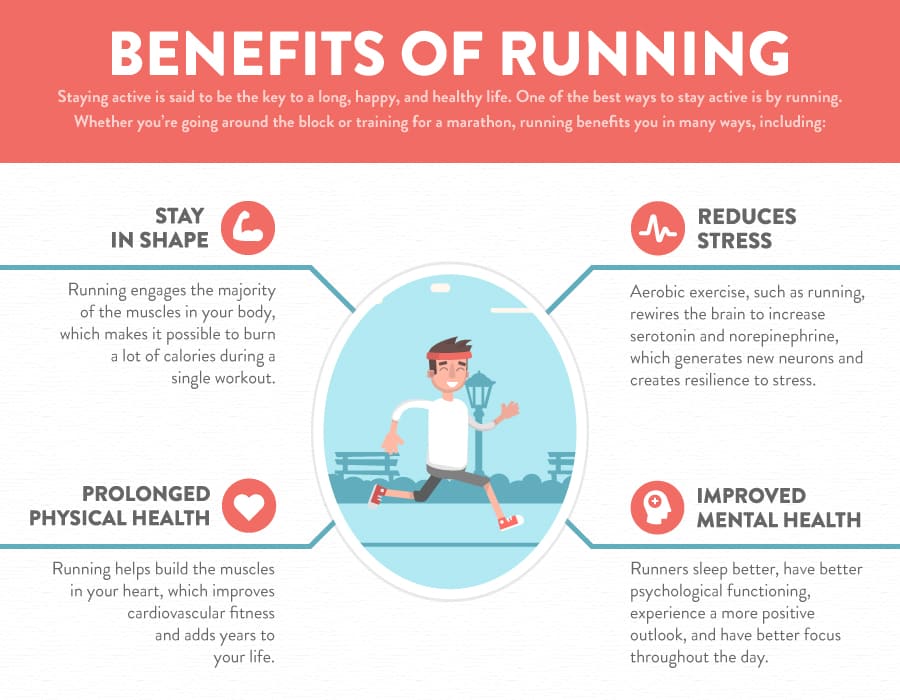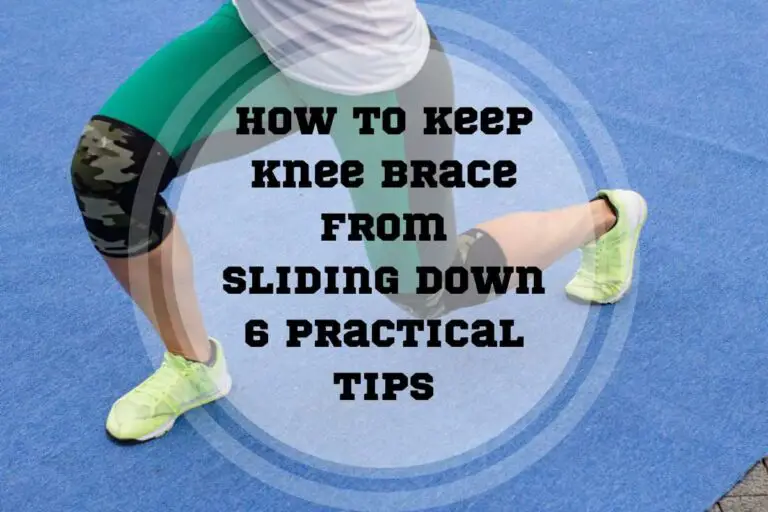Running 3 Miles a Day: Benefits, Risks and Simple Steps to Start
Running is one of the most popular forms of exercise because of its various benefits. It’s a great way to improve cardiovascular health, lose weight, and maintain a healthy lifestyle. Many people practice running 3 miles a day to stay healthy and fit. It can be a great way to improve your overall health and fitness level, and it’s also a great way to relieve stress, clear your head, and get some fresh air.
In this article, we will discuss the many benefits of running 3 miles every day and provide some tips and tricks for getting started. Whether you’re a beginner, mid-level, or experienced runner, this guide will help you get the most out of your runs and reach your fitness goals. So let’s get started!
How Running 3 Miles a Day Can Change My Body?
Running 3 miles a day is beneficial for your body, mind, and sleep. It can help you lose weight, improve your mental health, strengthen your body, and maintain good shape. It is an easy distance that suits all-level runners and has low health risks.
Why is 3 Miles a Perfect Distance for Runners of Any Level?
Running is a great way to stay fit and healthy, and running 3 miles is a popular distance among runners of all levels. However, the time it takes to run 3 miles can vary greatly depending on your fitness level and experience.
Beginners
For beginners, running 3 miles can be a challenging goal to work towards. If you are new to running, start slow and gradually increase your distance. On average, it can take a beginner runner anywhere from 30 to 40 minutes to run 3 miles.
Mid-level Runners
Mid-level runners have some experience with running and have built up some endurance over time. Running 3 miles can take from 20 to 30 minutes for these runners. However, this time can vary depending on fitness level and training routine.
Experienced Runners
Running 3 miles is a relatively short distance for experienced runners, and they can complete it in as little as 15 to 20 minutes. However, this time can also vary depending on age, experience, and overall health.
Is Running 3 Miles in 30 Minutes Good?
It depends on your fitness level and goals.
Running 3 miles in 30 minutes can be a great achievement if you are a beginner. It shows you have built enough endurance and stamina to complete a relatively long run in a reasonable amount of time.
However, if you are an experienced runner, running 3 miles in 30 minutes may be considered average. Many runners aim to run faster, especially if they are training for races or looking to improve their fitness level.
Whether you are a beginner or an experienced runner, listen to your body and gradually build up your endurance over time. Dedication and perseverance can improve your running time and help you reach your fitness goals.
[embedpress]https://www.instagram.com/p/CuZY1XpIJNJ/[/embedpress]
Is Running 3 Miles a Day Good for You?
The answer depends on factors such as your fitness level, age, health condition, and goals. Running 3 miles a day can benefit some people, while it may not be enough for others.
If you are new to running, 3 miles a day can be a great starting point to improve your cardiovascular fitness and endurance. It can also help you burn calories and manage weight.
However, if you are an experienced runner or have specific fitness goals, such as training for a marathon, running 3 miles a day may not be sufficient. In such cases, you may need to increase your running distance and intensity.
It is also important to listen to your body and avoid overtraining, which can lead to injuries and burnout. If you experience pain or discomfort while running, take a break and consult a healthcare professional.
Running 3 Miles A Day: Benefits for Body, Mind, and Sleep

Running can aid your body, mind, and even your sleep. Here are some of the key benefits of running three miles a day:
Benefits for the Body
- Weight loss: Running 3 miles a day can help you burn calories and lose weight, especially with a healthy diet.
- Stronger bones: Running is a weight-bearing exercise that can help improve bone density and reduce the risk of osteoporosis.
- Improved cardiovascular health: Running can help lower your blood pressure, reduce your risk of heart disease, and improve your overall cardiovascular health.
- Reduced risk of chronic diseases: Regular exercise like running can help reduce your risk of chronic diseases like type 2 diabetes, stroke, and certain types of cancer.
Benefits for the Mind
- Reduced stress and anxiety: Running can be a great way to reduce stress and anxiety, thanks to the release of endorphins and other chemicals in the brain.
- Improved mood: Regular running can help improve your mood and reduce symptoms of depression.
- Better cognitive function: Some studies have suggested that regular exercise like running can help improve cognitive function and reduce the risk of cognitive decline as you age.
Benefits for Better Sleep
- Faster time to fall asleep: Regular exercise like running can help you fall asleep faster and enjoy better quality sleep.
- Deeper sleep: Running can help you achieve deeper, more restorative sleep, leaving you feeling refreshed and energized in the morning.
- Reduced risk of sleep disorders: Regular running can help reduce the risk of sleep disorders like insomnia and sleep apnea.
Running 3 miles every day can benefit your body, mind, and sleep. Whether you want to lose weight, reduce stress, or improve your overall health, running is a great exercise to incorporate into your routine.
What Happens In Your Body During A 3-Mile Run?
How will running 3 miles a day change my body? When you start running, your body undergoes many changes to meet the demands of the exercise. Your heart rate increases to pump more blood to your muscles, delivering oxygen and nutrients to the areas that need them the most. This increased blood flow also helps to remove waste products from your muscles, such as lactic acid, which can cause fatigue and soreness.
As you continue to run, your breathing rate increases to absorb more oxygen and expel carbon dioxide. This exchange of gasses is essential for providing your body with the necessary oxygen to create energy. Your body temperature also rises due to the increased activity, and you begin to sweat to cool down. Sweating helps to regulate your body temperature, preventing overheating and allowing you to continue running.
During a 3-mile run, your body burns calories and converts stored carbs into energy. Your leg muscles work to push you forward, and your core muscles help stabilize your body. This stabilization is important for maintaining proper form and preventing injury. As you near the end of your run, your body may feel fatigued, and you may experience a decrease in running efficiency. This is due to a depletion of energy stores and the accumulation of waste products in your muscles.
After your run, your body continues to burn calories as it works to repair damaged tissues and replenish energy stores. Your heart rate slowly returns to its resting rate, and your breathing becomes regular. It is important to stretch your muscles to prevent injury and reduce soreness. Stretching can also help improve flexibility and range of motion, enhancing athletic performance.
How Much Weight Can You Lose Running 3 Miles A Day?
Running can help you lose weight and improve your overall health. If you’re wondering how much weight you can lose by running 3 miles a day, the answer depends on a few factors.
Firstly, it’s important to understand that weight loss is a complex process that involves many factors, such as your diet, genetics, and lifestyle. Running 3 miles a day to lose weight can certainly contribute to success, but it’s not guaranteed that you will easily shed the pounds.
How Many Calories Are Burned on a 3-Mile Run?
Running is a high-intensity workout that can help you burn calories while strengthening your muscles.
On average, running 3 miles burns around 300-400 calories, depending on your weight and intensity level.
This means that if you jog 3 miles a day and maintain a healthy diet, you can achieve a calorie deficit and lose weight. However, if you’re new to running or have a lot of weight to lose, it’s important to start slow and gradually increase your mileage. Running too much too soon can lead to injury and burnout. Start with a slow jog and then gradually increase your pace and distance.
Additionally, focus on eating a healthy, balanced diet that includes plenty of fruits, vegetables, lean protein, and whole grains. This will help you fuel your runs and support your weight loss goals. Eating a balanced diet will also give your body the necessary nutrients to recover after a run and prevent injuries.
Overall, running three miles a day for a month can help you lose weight, but it’s important to take a healthy approach to weight loss that includes exercise and a healthy diet.
Subscribe to Our Running Newsletter!
Get free running tips from renowned professional athletes and discounts from top-notch brands.
Running 3 Miles a Day Transformation – Before and After
If you maintain a consistent running routine and make no other changes to your lifestyle, running 3 miles a day before and after can result in 1-2 pounds per week. This is based on the general rule of thumb that you need to create a calorie deficit of 3,500 calories to lose 1 pound of body fat a week.
A person who has many pounds to shed may be able to lose between 4-8 pounds per month, running 3 miles a day. On the other hand, a person who has a couple of excess pounds may lose around 2-4 pounds per month.
However, it’s important to keep in mind that weight loss is not just about exercise. It’s also about creating a sustainable and healthy lifestyle that includes a balanced diet and regular physical activity. Running 3 miles a day can be a great addition to a healthy lifestyle, but it should be combined with other healthy habits for the best results.
3 Disadvantages of Running 3 Miles a Day
What will running 3 miles a day do for your body? It may have several benefits, including improving cardiovascular health, strengthening muscles and bones, and reducing the risk of chronic diseases. However, there are also some potential disadvantages and risks associated with this activity, such as:
1. Overuse Injuries
Running is a high-impact activity that can put a lot of strain on the joints, muscles, and bones. Overdoing it, especially without proper rest and recovery, can increase the risk of overuse injuries such as shin splints, stress fractures, and tendonitis.
2. Muscle Imbalances
Running mainly loads the lower body, which can lead to muscle imbalances if other muscle groups, such as the upper body and core, are neglected. This can result in poor posture, reduced athletic performance, and an increased risk of injury.
3. Mental Health
While running can be beneficial for mental health, it may also have some negative impacts, especially if done excessively or compulsively. It can become an addiction, leading to feelings of guilt, anxiety, or depression if missed or skipped.
5 Tips for Getting the Most out of Running 3 Miles a Day
Whether you are a seasoned runner or just starting out, you can follow a few tips to get the most out of your daily runs.
1. Warm Up Before You Run
Before you start running, it’s important to warm up your muscles to prevent injury. Try doing some light stretching or walking for a few minutes before you start your run.

2. Stay Hydrated
Make sure to drink plenty of water before and after your run. Dehydration can cause fatigue and muscle cramps, making running more difficult.
3. Wear the Right Shoes
Pick a good pair of running shoes designed for your specific foot type. This will help prevent injuries and make your runs more comfortable.
4. Mix Up Your Workouts
Try alternating your running routine with other forms of exercise, such as weight lifting or yoga. This can help prevent boredom and improve your overall fitness.
5. Track Your Progress
Keep a record of your runs and track your progress over time. This can help you stay motivated and see improvements in your running ability.
5 Tips How to Start Running 3 Miles A Day
Are you looking to increase your running distance to 3 miles a day? Here are 5 tips to help you get started:
1. Start slow
Don’t try to run 3 miles on your first day. Start with a comfortable pace and distance and slowly increase it over time. This will help you avoid injury and build endurance.
2. Set realistic goals
It’s important to set realistic and achievable goals. Set a goal to run for a certain amount of time or distance each day and gradually increase it. If you’re not used to running, don’t expect to run 3 miles a day in one week.
3. Get the proper gear
Make sure you have the proper shoes and clothing for running. Invest in a good pair of running shoes that provide support and help prevent injury.

4. Follow a training plan
Many training plans are available online that can help you work up to running 3 miles a day. Find one that works for you and stick to it.
5. Stay motivated
Running can be challenging, but staying motivated is important. Find a running buddy or join a running group to help keep you accountable and motivated.
By following these tips, you’ll be well on your way to running 3 miles a day. Remember to take it slow and steady, and enjoy the journey!
Frequently Asked Questions About How to Run 3 Miles a Day
How Will Running 3 Miles a Day Change My Body?
It improves your cardiovascular health and boosts your endurance, but it can also help you lose weight and tone your muscles. Running 3 miles a day can also reduce your risk of chronic diseases such as diabetes and high blood pressure.
Does Running 3 Miles a Day Build Muscle?
While running 3 miles a day can help tone your muscles, it is not the most effective way to gain muscle mass. To build muscle, you should focus on strength training exercises like weightlifting or bodyweight exercises.
Is 3 Miles in 30 Minutes Good?
For beginners, 3 miles in 30 minutes is a good start. That’s about 10 minutes per mile, which is perfectly acceptable for building endurance. Advanced runners can reach a faster pace, around 7-8 minutes per mile. Beginners can use this pace to gradually improve their results and timing, while advanced runners can use it as a moderate workout. Remember that consistency is key and achieving this means improving your running results.
Summing Up How Running 3 Miles a Day Can Change Your Body
After analyzing the benefits and drawbacks of running 3 miles a day, it can be concluded that this exercise routine is an excellent way to maintain good physical and mental health. Regular running can help improve cardiovascular health, strengthen muscles, and increase endurance. It can also lead to weight loss and improve mood and mental health.
Running three miles a day can be a beneficial exercise if done in moderation and with proper form and technique. It’s important to also incorporate strength training and stretching into your routine to prevent muscle imbalances and increase flexibility. Stay hydrated and fuel your body with nutritious foods to support your running performance and recovery.
Have you tried running 3 miles a day? Please share your experience in the comments below!
Also read:
- How Many Miles Should I Run a Day
- How to Run a Faster Mile
- Do I Need to Fuel During a Half Marathon
- Running 5 Miles a Day
- 10 Minute Mile
- Average Running Speed
- Why Is My Heart Rate High on Easy Runs
- 100 Mile Training Plan
- Best Shoes for Peroneal Tendonitis
References:
- The effect of long-distance running on bone strength and bone biochemical markers // PMC: https://www.ncbi.nlm.nih.gov/pmc/articles/PMC6416492/
- Running Changes the Brain: the Long and the Short of It // PMC: https://www.ncbi.nlm.nih.gov/pmc/articles/PMC6148340/
- The bidirectional relationship between exercise and sleep: Implications for exercise adherence and sleep improvement // PMC: https://www.ncbi.nlm.nih.gov/pmc/articles/PMC4341978/
- Greater Weight Loss from Running than Walking during 6.2-yr Prospective Follow-up // PMC: https://www.ncbi.nlm.nih.gov/pmc/articles/PMC4067491/
- Does running with or without diet changes reduce fat mass in novice runners? A 1-year prospective study // PubMed: https://pubmed.ncbi.nlm.nih.gov/25766050/
If you have any questions or suggestions, you can contact us via email – [email protected]






